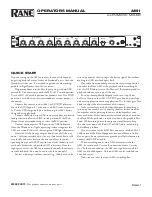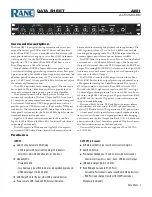
3.
MICROPHONE CASSETTE
3.1
Channels
Each Microphone Cassette contains two identical channels, which can be
used either for two mono microphones or for a stereo pair.
3.2
Input Socket
A 5-pin Tuchel socket is used for the two inputs. Each input is provided with a
screened input transformer having a step-up ratio of 1: 3.16 the primary winding of
which is intended to operate from a 200
Ω
source.
3.3
Condenser Microphone Powering
Provision is made for 50V phantom powering of condenser microphones. A
pair of 6.8 k
Ω
resistors the values of which are balanced to within 0.5% is
connected in series across each input circuit. The common points of these two
pairs are connected to the sliders of a 2-pole 4-way switch whereby neither, either
or both can be connected to the positive side of a 50V D.C. supply. The unit
providing this supply is located in the main power unit. Its output is brought in a pair,
with the 50V a.c. supply to the Control Room Monitor Cassette. It is then distributed
to the Microphone Cassettes through the main cableform. The negative side of this
supply is connected to the 0 V line in the Control Room Monitor Cassette.
3.4
Input Circuit
3.4.1 Coarse Input Level Control
The Coarse input level control provides 12 steps of attenuation of 5dB each.
In order to maintain a high input impedance, and to ensure that the noise of the
channel is less at all intermediate settings of the input level control than at the zero
loss setting, the first three 5dB steps are obtained from tappings on the input
transformer secondary winding. The remaining steps are obtained by means of a
resistive potentiometer of 8.33k
Ω
total resistance.
3.4.2 Input amplifier and Fine Gain Control
This is an Amplifier D described in 12.27. Its nominal voltage gain is 25dB.
Used as it is in conjunction with the fine input gain control, which has a range of
±
5dB in 0.5dB steps, an effective voltage gain from 20 to 30dB can be obtained.
The fine gain control operates in the feedback circuit of the Amplifier D.
3.4.3 Range of Input Levels
For the standard level of –10dBV at the output of the Amplifier D, the level at
the input of the Amplifier D can be between –30 and –40dBV. The level at the
secondary of the transformer can therefore be b30 and –40dBV so that the
corresponding range of input voltage is from +20 to –50dBV.















































